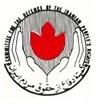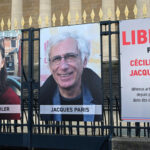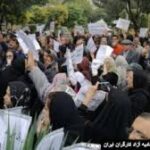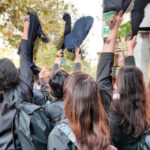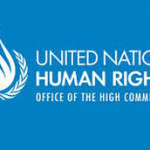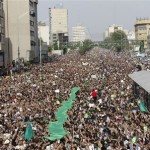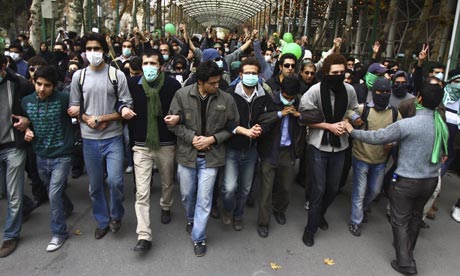
Tuesday 8 December 2009
Massoumeh Torfeh
guardian.co.uk
Pro-reform Iranian students march during a protest at the Tehran University campus in Iran. Photograph: AP
The ruling clique in the Islamic republic must face the fact that it can no longer brush under the carpet the disenchantment of the young and educated in Iran. Nor can it convince anyone through its show trials that “spies” working to the orders of America and Britain organise all these regular demonstrations. The supreme leader, Ali Khamenei, repeated the claim again on Sunday.
The cliche sentences dividing the nation into those who are “with us” and those who are “with our enemies” have been heard far too long to be effective. After 30 years of the Islamic republic, the young seem to be searching for new political ideas while the establishment seems to be running out of breath. The more autocratic a regime becomes, the more it tightens its controls and the harsher its response, the more it reveals its fragile disposition.
The students came out across the country in their thousands and warned that they preferred their religion to be kept in the private domain. And in a bolder show of defiance they directly blamed the supreme leader for continuing to support the contested president, Mahmoud Ahmadinejad.
“The government commits crimes, the leader gives it support,” chanted demonstrators setting light to pictures of Khamenei and Ahmadinejad. They even sent a message of disapproval to the main opposition leader, Mir Hossein Mousavi: “Mousavi is an excuse, the target is the regime,” they shouted. Another slogan hit the leader more indirectly: “Students are awake, dictators, they detest.”
Dozens were arrested after fierce clashes with security forces. But when, despite security clampdowns and threats on people’s lives, demonstrators keep returning to the streets the question keeps being posed: “Why can’t the regime regain control?” Opposition leader Mousavi warned the authorities that the green movement would continue: “You may be able to clamp down on 7 December but what will you do on 8 December and 9 December?” he said in a statement on the eve of Students’ Day. The next day, female Basij militia attacked his wife, Zahra Rahnavard, as she tried to join the demonstrations.
The more the regime tries to pretend dissent is limited, the more new defiant groups seem to flourish. Mothers of those who were killed or imprisoned during the last six months now have a weekly gathering at a park near Tehran University where they voice their objection to the government’s inaction in bringing to justice those responsible for killing their children. Women’s movement activists also increasingly join in. Last Saturday more than 20 women were arrested while protesting.
During the weeks leading up to Students’ Day (7 December), dozens of student leaders were arrested to block them from organising protests. It is a symbolic day to mark the student movement’s leading role in the process of democratisation in Iran. This year the students used it for expressing their dismay with suppression of academic freedoms. They also used the colour green on the design of their posters to indicate that they have accepted the green movement as their own.
Students are increasingly angered since many are harassed for political activism and barred from their university. There is also disenchantment with the way study subjects are being replaced by religious studies in the curriculum. Teaching of political thought is limited to Islamic and religious thought. Women students who win about 70% of university entrance places are being told they cannot attend to make room for more men. It is these daily frustrations that brought large numbers of students to demonstrations, not just in Tehran but also in Mashhad, Arak, Kerman, Shiraz and Isfahan.
During the past few months the regime has also increasingly angered journalists. Dozens are held in prison and subjected to humiliation and misrepresentation. Reporters Without Borders said many journalists had been intimidated and arrested in the past two weeks leading to Students’ Day:
The press freedom situation is getting worse by the day in Iran.
Journalists who have chosen not to the leave the country are being constantly threatened or summoned by the intelligence services, including the intelligence service of the Revolutionary Guards. Some have been given long prison sentences at the end of completely illegal judicial proceedings.
The editor of Aftab e Yazd – usually not regarded strictly speaking as opposition received a warning not to publish anything “divisive”. The editor replied saying it had only published the speeches by “the regime’s top politicians”, namely the head of the expediency council, Hashemi Rafsanjani. He had said in a meeting with students in Mashhad: “Censorship is ineffective in our country. If media were free people would not come out in the streets.” Apart from Aftab e Yazd, three other newspapers – Asrar, Hayat e Now, and Etemad received the same warning. Hayat e Now has now been closed down.
Thus dissent is on the increase. And the government’s inability to deal with their demands strengthens the protesters’ resolve. Slogans in protests have moved from “Where is our vote?” to directly confronting the Islamic republic’s political structure.
Over the next few months the opposition demonstrations will continue and are likely to be joined by people from other layers of society who may object to planned substantial cuts in government subsidies. The likelihood is that the brutality of the security forces in dealing with demonstrators will also increase.


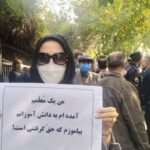



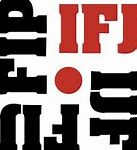



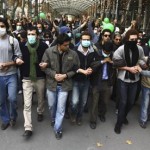
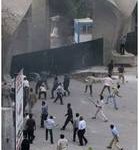
 Posted in
Posted in 